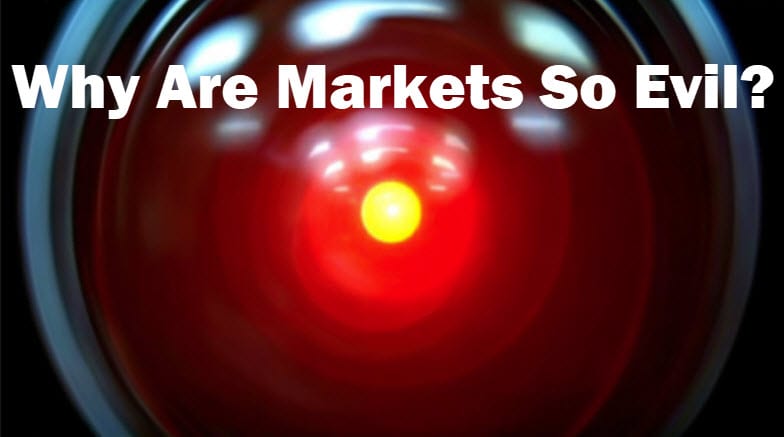Why are financial markets so evil? Why do they move in the exact opposite direction that you want them to when you commit to a position? When you buy, the price drops. When you sell, the price moons right afterwards. When it looks like the coast is clear and everything’s positive, the market crashes. Is it you, or is it someone pulling the strings that hates you and is doing their best to ensure your doom?

Unfortunately, those that are relatively new to financial markets will buy into the FUD that some evil player is out there pulling the strings on this market, but unless your chosen market to trade is extremely illiquid and therefore prone to manipulation, no one entity can control the market for any length of time before the vacuum gets filled. (and EVERY financial market is manipulated to some extent by those with the means to do so) After trading financial markets for the past 23 years and making every mistake in the book, I’ve noticed that there are some very simple, specific reasons why markets act like this, and it has everything to do with the way that we all think.
What do we investors want? CERTAINTY and REDUCTION OF RISK.We’d all like some kind of reassurance that we’ll get our money back plus some return. And where do most people search for certainty and reduction of risk? BY ASKING OTHERS.
We do this in our daily lives by searching product review ratings before we buy something. And those that have dined at a restaurant lately, or have bought a product on amazon and given it a five-star review can generally be trusted to provide honest, true information to reduce the risk of you making a bad purchase. We compare top ten reviews and comparisons before we buy a car, shouldn’t the same logic apply when investing?
NO!
By taking mass social input into your investing decisions, you automatically become part of the largest, least knowledgeable group of investors. And these are also the ones most likely to panic and make rash decisions when things don’t instantly go their way, which is almost assured to happen with normal volatility. Markets will move around and these folks can’t stand the heat, and will bail at the first sign of adverse price movement.
This is the equivalent of standing up and yelling “FIRE!!!” in a crowded theater. And now with social media at everyone’s fingertips, you can amplify your fear globally and start the panic.
And this works in both directions; we recently saw a “panic to buy” as the price of Bitcoin approached $14k, because….hey this might be the very last rally we’ll ever see, right? Rallies cause pain just like sell-offs, and the resultant exponential rise causes those who were bearish/short to buy back their position to close it (adding demand to the mix) and the higher that the price goes, those who were patiently waiting for a pullback finally panic and buy in, afraid to miss the train.
And as we can see by this week’s pullback down below $10k, that mass hysteria was the worst possible thing that you could have followed. If you bought at the highs, you’re already down 28% on your position and contemplating choices in life. It’s that evil market’s fault, right? Not really, can you see how you brought that pain on yourself by becoming part of the mass of Retail investors?
So now, let’s look at the flip side. Bitcoin has been selling off since it peaked out near $14k, and this is where investors that were previously posting on twitter that they couldn’t wait to buy the dip as the price was rising…are nowhere to be found, with their heads buried into the sand.

“This pullback doesn’t feel right. Besides, someone said that Bitcoin was heading to $1300 again. Better be safe.”
And this is why we had correction after correction in the last Bitcoin bull where people sold out at the bottom of the pullback and subsequently failed to buy the dip.
This is what happens when you try to trade this market by feel, or by plugging into social media for direction. You automatically make yourself part of the largest and least-sophisticated group of traders out there.
How do you fix this and become part of the “smart money” instead?
First off, you have to fundamentally understand how crowd psychology works, and it’s different these days with social media. Being part of a trend is great and is when most of the gains occur, but if you want an edge over the rest of the market, you simply must find a way to get an edge over the herd by entering near the bottom of the move when the situation feels more uncertain, not at the top where the reward is low and risk is high.
Secondly, to find these “better” entries, you have to follow a trading system that takes your discretionary judgment out of the loop. None of the good entries will feel like you’re creating certainty or reducing risk…quite the opposite, in fact.
Lastly, you have to be willing to do the things that the majority of people either CANNOT or WILL NOT do.
Markets by themselves are not evil. We become our own worst enemies when we follow the crowds and invest.
Be independent, and beat the market.
Doc Severson
Westerville, OH

